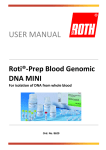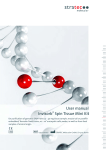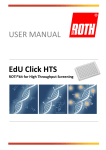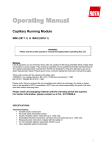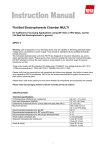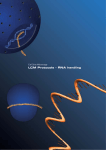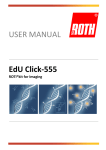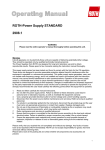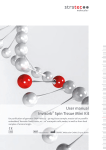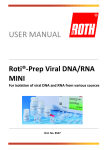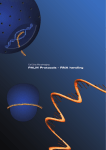Download User manual / Technical Information
Transcript
USER MANUAL Roti®-Prep Genomic DNA MINI For isolation of genomic DNA from tissues Ord. No. 8472 Roti®-Prep Genomic DNA MINI Carl Roth GmbH + Co. KG Roti®-Prep Genomic DNA MINI For isolation of genomic DNA from tissues, rodent tails, FFPE tissues, buccal swabs, cell cultures Introduction and product description: Preparation by well-known mini spin-column system Fast, easy and efficient Preparation in approx. 15 minutes (excluding lysis) Yield up to 65 µg gDNA, depending on source material Roti®-Prep Genomic DNA MINI has been developed for the isolation of genomic DNA from various sources. The isolation is carried out through the proven and reliable spin column technique, which is very easy to handle and needs only few steps. In addition to the especially on proteinase K adapted lysis buffer, the filtration spin column has been optimised, permitting particularly high extraction rates. Extraction from up to 40 mg tissue, therefore, allows a yield of up to 65 µg gDNA. The thereby extracted DNA is free of RNA and proteins, and can directly be stored or used for downstream applications. Figure: Typical test gel following isolation of genomic DNA (A) and subsequent GAPDH-PCR (B) from rodent tail (frozen, 8 mm each). Yield of gDNA (from left to right): 22.6 µg, 27.7 µg and 28 µg. Ratio A260:A280 = 1.97±0.01. Suitable source material: Tissue (up to 40 mg) Rodent tails (0.5 – 1 cm) FFPE tissue (paraffin embedded tissue) Buccal swabs Cell culture (up to 5x106 cells) For research use only. Roti®-Prep Genomic DNA MINI Carl Roth GmbH + Co. KG Information in this document is subject to change without notice. Carl Roth GmbH + Co. KG assumes no responsibility for any errors that may appear in this document. Carl Roth GmbH + Co. KG disclaims all warranties with respect to this document, expressed or implied, including but not limited to those of merchantability or fitness for a particular purpose. In no event shall Carl Roth GmbH + Co. KG be liable, whether in contract, tort, warranty, or under any statute or on any other basis for special, incidental, indirect, punitive, multiple or consequential damages in connection with or arising from this document, including but not limited to the use thereof. Cautions: Lysis Buffer LSA* Binding Buffer BSN Proteinase K Warning H319 P305+P351+P338-P337+P313 Danger H225-H318-H336-H411 P210-P280-P303+P361+P353-P305+P351+P338-P312 Danger H315-H319-H334-H317-H335 P260-P280-P342+P311 *In case of forming of precipitates, please dissolve by careful warming. MSDS: the appropriate MSDS can be downloaded from our website www.carlroth.com. All due care and attention should be exercised in handling the materials and reagents contained in the kit. Always wear gloves while handling these reagents and avoid any skin contact! In case of contact, flush eyes or skin with a large amount of water immediately. Literature Citation: When describing a procedure for publication using this product, please refer to it as Carl Roth’s Roti®-Prep Genomic DNA MINI Kit. 1. Materials provided with the kit and storage conditions Amount 6 / 30 / 5x30 mg 10 / 25 / 120 ml 16 / 16 / 60 ml 6 / 24 / 2x60 ml 2x2 / 15 / 2x30 ml 10 / 50 / 250 20/ 100 / 500 10 / 50 / 250 Component Proteinase K Lysis Buffer LSA Binding Buffer BSN Washing Buffer WST (Base) Elution Buffer EB Mini spin columns (blue) 1.5 ml Elution tubes 2 ml Collection tubes 3 Storage +4 °C / -20 °C* >20 °C** RT RT RT RT RT RT Carl Roth GmbH + Co. KG Roti®-Prep Genomic DNA MINI * Lyophilized Proteinase K should be stored at +4 °C. Prior to use, dissolve Proteinase K in 0.3 / 1.5 / 5x1.5 ml sterile, distilled water as given below. Dissolved Proteinase K should be stored in aliquots at -20 °C. Avoid repeated freeze&thaw cycles for each tube. ** Lysis Buffer should be stored at over 20 °C in order to prevent precipitation of reagents. The Roti®-Prep Genomic DNA MINI Kit should be stored dry, at room temperature (14-25 °C). Before every use make sure that all components have room temperature. If there are any precipitates within the provided solutions solve these precipitates by careful warming. This kit is stable for at least 6 months after receipt, when stored as directed. Contents of this Kit may not be bought separately. The user is responsible to validate the performance of the Roti®-Prep Genomic DNA MINI Kit for any particular use, since the performance characteristics of our kits have not been validated for any specific application. 2. Required Material and Equipment not included in this kit Ethanol 96-99.8 %, e.g. Ethanol p.a. (e.g. 9065.1) Distilled, sterilized H2O RNAse A, stock solution 100 mg/ml (e.g. 7156.1, 100 mg solubilized in 1 ml distilled water, made DNAse-free by cooking) Xylene or octane (optional) 3. Application Roti®-Prep-Genomic DNA MINI is designed for isolation of high-purity genomic DNA from various source material. Spin column based preparation allows elution in a small volume of low-salt buffer, eliminating time-consuming phenol-chloroform extraction or alcohol precipitation. The columns may be used either in micro-centrifuges or on vacuum manifolds. The kit allows the extraction of up to 65 µg gDNA per preparation from up to 40 mg of rodent tails (0.5 – 1 cm), paraffin embedded tissue, buccal swabs or cultured cells (up to 5x106). During lysis, the sample has to be mixed carefully and, if possible, constantly. Reduced movement of the lysis mix will reduce the lysis efficiency, and, subsequently, the recovery rate of gDNA. We recommend using a shaking platform or thermomixer in order to keep the sample at constant movement. When elution DNA from buccal swabs, we recommend to keep the swab in the tube during the whole lysis procedure, in order to achieve a maximum yield of DNA. In order to enable closing of the cap the shaft may be cut, however. Removal of the swab from the tube ahead of time will lead to a dramatically reduced yield! Repetition of elution (final step) often enhances the recovery rate overall. However, even so often, concentration of the recovered gDNA is reduced in parallel, since the whole amount 4 Roti®-Prep Genomic DNA MINI Carl Roth GmbH + Co. KG of buffer used for elution is higher. Elution is 100 µl Elution Buffer EB, followed by another elution step in 100 µl Elution Buffer EB, may be recommended. Store the extracted DNA at +4 °C. For long time storage placing at -20 °C is recommended. For centrifugation we recommend a standard microcentrifuge. Centrifugation steps should be carried out at room temperature. Avoid repeated freeze&thaw cycles for the tissue to be extracted. Before start, be sure to - Add Ethanol (96-99.8 %, not incl. in this kit) to the Washing Buffer WST as follows: 8472.1 (10 Preps): 14 ml (20 ml final vol.) 8472.2 (50 Preps): 56 ml (80 ml final vol.) 8472.3 (250 Preps): 140 ml to each bottle (2x 200 ml final vol.) Mix thoroughly and keep the bottle always firmly closed! - Dissolve Proteinase K by addition of distilled H2O as follows: 8472.1 (10 Preps): 0.3 ml 8472.2 (50 Preps): 1.5 ml 8472.3 (250 Preps): 1.5 ml to each tube Mix thoroughly! - Heat one thermal mixer or water bath to 50 °C. - For elution from paraffin embedded tissue: be prepared to heat another thermal mixer or water bath to 90 °C. Please note: Centrifugation steps should be carried out at room temperature 4. Workflow The workflow has been provided on a separate page, in order to use a copy for in-process protocol or filing in your personal lab files. 5 Carl Roth GmbH + Co. KG Roti®-Prep Genomic DNA MINI 4.1 DNA isolation from tissue samples or rodent tails (max. 10 mg tissue or 1 cm tail section) Step (RT = room temperature) done 1. Tissue lysis Cut max. 40 mg of tissue sample into small pieces and place the tissue into a 1.5 ml or 2.0 ml reaction tube. Add 400 µl Lysis Buffer LSA, 25 µl Proteinase K solution, and 3 µl RNase A (stock solution 100 mg/ml; not included in the kit). Mix vigorously by pulsed vortexing for 5 sec. Incubate at 50 °C under constant agitation* until the sample is completely lysed, approx. 0.5-2 h for tissue sample and 3 h for rodent tails.** After lysis has been completed, centrifuge the lysed sample at 10.000 g (or 12.000 rpm) for 30 sec to spin down unlysed material. Transfer the supernatant to a fresh 1.5 ml reaction tube. Add 200 µl Binding Buffer BSN to the supernatant. Mix by vortexing or pipetting until a homogenous solution is achieved. 2. Column Loading Place each Spin Column into a 2 ml collection tube Apply the mix of supernatant/Binding Buffer BSN to the spin column. Centrifuge at 10.000 g (or 12.000 rpm) for 2 min/RT and discard the flow-through.*** 3. Column Washing Add 700 µl of Washing Buffer WST to the Spin Column Centrifuge at 10.000 g (or 12.000 rpm) for 1 min/RT and discard the flow-through*** Add 700 µl of Washing Buffer WST to the Spin Column Centrifuge at 10.000 g (or 12.000 rpm) for 1 min/RT and discard the flow-through*** Again centrifuge columns at 12.000-14.000 rpm (or full speed) for 2 mins/RT in order to remove residual ethanol. 4. Elution Place the Spin Column into a clean 1.5 ml elution tube Add 200 µl Elution Buffer EB to the centre of the membrane**** Incubate for 1 min at room temperature Centrifuge at 6.000 g (or 8.000 rpm) for 1 min/RT to elute DNA * We recommend using a shaking platform or thermomixer for continuous agitation of the sample. Alternatively, vortex the sample 3-4 times during incubation. Agitation is vital for a decent recovery rate. ** Check lysis efficiency before proceeding in the protocol. If the lysis is not complete, prolong the incubation time in Lysis Buffer LSA. This step is critical, don’t be impatient. *** If the solution has not completely passed through the spin column, centrifuge again at higher speed or prolong the centrifugation time. **** Elution with lower volumes of Elution Buffer (e.g. 100 µl Elution Buffer only) increases the final concentration of DNA. Repetition of the elution step often increases the yield of gDNA overall, but may reduce the concentration after pooling of the fractions. 6 Roti®-Prep Genomic DNA MINI Carl Roth GmbH + Co. KG 4.2 DNA isolation from paraffin embedded tissue samples Step (RT = room temperature) done 1. Deparaffination Place the sample into a 2.0 ml tube, add 1 ml Octane or Xylene. Vortex carefully to dissolve the paraffin. Monitor this process carefully until the tissue sample looks transparent (while paraffin remains white). Centrifuge at max. speed for 5 mins/RT. Discard the supernatant very carefully by pipetting. Do not remove the pellet. Check the sample carefully and repeat the last step until the sample is completely transparent. Add 1 ml ethanol (96-99.8 %) to the pellet and vortex vigorously. Centrifuge at maximum speed for 3 min/RT and remove the ethanol by pipetting. Do not remove the pellet. Add 1 ml ethanol (96-99.8 %) to the pellet and vortex vigorously. Centrifuge at maximum speed for 3 min/RT and remove the ethanol by pipetting. Do not remove the pellet. Incubate the open tube at 37 °C for 10-15 mins to evaporate the residual ethanol. 2. Tissue lysis Add 400 µl Lysis Buffer LSA, 25 µl Proteinase K solution, and 3 µl RNase A (stock solution 100 mg/ml; not included in the kit). Mix vigorously by pulsed vortexing for 5 sec. Incubate at 50 °C under constant agitation* until the sample is completely lysed, approx. 0.5-2 h for tissue samples.** After lysis has been completed, place the sample into a thermomixer prewarmed at 90 °C and incubate the sample for 1 h.*** Add 200 µl Binding Buffer BSN to the sample. Mix by vortexing or pipetting until a homogenous solution is achieved. 3. Column Loading Place each Spin Column into a 2 ml collection tube Apply the mix of sample/Binding Buffer BSN to the spin column. Centrifuge at 10.000 g (or 12.000 rpm) for 2 min/RT and discard the flow-through.**** 4. Column Washing Add 700 µl of Washing Buffer WST to the Spin Column Centrifuge at 10.000 g (or 12.000 rpm) for 1 min/RT and discard the flow-through**** Add 700 µl of Washing Buffer WST to the Spin Column Centrifuge at 10.000 g (or 12.000 rpm) for 1 min/RT and discard the flow-through**** Again centrifuge columns at 12.000-14.000 rpm (or full speed) for 2 mins/RT in order to remove residual ethanol. 7 Carl Roth GmbH + Co. KG Roti®-Prep Genomic DNA MINI Sequel: DNA isolation from paraffin embedded tissue samples Step (RT = room temperature) done 5. Elution Place the Spin Column into a clean 1.5 ml elution tube Add 200 µl Elution Buffer EB to the centre of the membrane***** Incubate for 1 min at room temperature Centrifuge at 6.000 g (or 8.000 rpm) for 1 min/RT to elute DNA * We recommend using a shaking platform or thermomixer for continuous agitation of the sample. Alternatively, vortex the sample 3-4 times during incubation. Agitation is vital for a decent recovery rate. ** Check lysis efficiency before proceeding in the protocol. If the lysis is not complete, prolong the incubation time in Lysis Buffer LSA. This step is critical, don’t be impatient. During lysis, make sure to heat up a thermomixer or water bath to 90 °C. *** Only place the sample into the thermomixer when the temperature has reached 90 °C !!! **** If the solution has not completely passed through the spin column, centrifuge again at higher speed or prolong the centrifugation time. ***** Elution with lower volumes of Elution Buffer (e.g. 100 µl Elution Buffer only) increases the final concentration of DNA. Repetition of the elution step often increases the yield of gDNA overall, but may reduce the concentration after pooling of the fractions. 8 Roti®-Prep Genomic DNA MINI Carl Roth GmbH + Co. KG 4.3 DNA isolation from buccal swabs For a maximum yield of DNA, the swab has to remain in the tube during the whole lysis procedure. We recommend to cut the shaft of the swab, in order to enable closing of the cap. Removal of the swab from the tube ahead of time will lead to a dramatically reduced yield! Step (RT = room temperature) done 1. Tissue/cell lysis Place the swab into a 1.5 ml or 2.0 ml reaction tube and cut the shaft. Add 400 µl Lysis Buffer LSA, 25 µl Proteinase K solution, and 3 µl RNase A (stock solution 100 mg/ml; not included in the kit). Mix vigorously by pulsed vortexing for 5 sec. Incubate at 50 °C under constant agitation* for 10-15 mins. Remove the swab by pressing the tip of the swab to the inner tube wall, in order to quantitatively squeezing the liquid from the cotton wool into the tube. Add 200 µl Binding Buffer BSN to the sample. Mix by vortexing or pipetting in order to achieve a homogenous solution. 2. Column Loading Place each Spin Column into a 2 ml collection tube Apply the mix of sample/Binding Buffer BSN to the spin column. Centrifuge at 10.000 g (or 12.000 rpm) for 2 min/RT and discard the flow-through.** 3. Column Washing Add 700 µl of Washing Buffer WST to the Spin Column Centrifuge at 10.000 g (or 12.000 rpm) for 1 min/RT and discard the flow-through** Add 700 µl of Washing Buffer WST to the Spin Column Centrifuge at 10.000 g (or 12.000 rpm) for 1 min/RT and discard the flow-through** Again centrifuge columns at 12.000-14.000 rpm (or full speed) for 2 mins/RT in order to remove residual ethanol. 4. Elution Place the Spin Column into a clean 1.5 ml elution tube Add 200 µl Elution Buffer EB to the centre of the membrane**** Incubate for 1 min at room temperature Centrifuge at 6.000 g (or 8.000 rpm) for 1 min/RT to elute DNA * We recommend using a shaking platform or thermomixer for continuous agitation of the sample. Alternatively, vortex the sample 3-4 times during incubation. Agitation is vital for a decent recovery rate. ** If the solution has not completely passed through the spin column, centrifuge again at higher speed or prolong the centrifugation time. *** Elution with lower volumes of Elution Buffer (e.g. 100 µl Elution Buffer only) increases the final concentration of DNA. Repetition of the elution step often increases the yield of gDNA overall, but may reduce the concentration after pooling of the fractions. 9 Carl Roth GmbH + Co. KG Roti®-Prep Genomic DNA MINI 4.4 DNA isolation from cultured cells (5 x 106 cells in maximum) Adherent cells should be loosened from the culture bottle surface by trypsination or EDTA. Remove cells and wash in PBS. Count your cell number and select the appropriate cell amount, 5x106 cells in maximum.* Step (RT = room temperature) done 1. Cell lysis Pellet cells by centrifugation at 5.000 g (or 7.500 rpm) for 10 mins and discard the supernatant.* Add 200 µl Lysis Buffer LSA, 25 µl Proteinase K solution, and 3 µl RNase A (stock solution 100 mg/ml; not included in the kit). Mix vigorously by pulsed vortexing for 5 sec. Incubate at 50 °C under constant agitation* until the sample is completely lysed, approx. 30 mins.** Add 200 µl Binding Buffer BSN to the sample. Mix by vortexing or pipetting until a homogenous solution is achieved. 2. Column Loading Place each Spin Column into a 2 ml collection tube Apply the mix of sample/Binding Buffer BSN to the spin column. Centrifuge at 10.000 g (or 12.000 rpm) for 2 min/RT and discard the flow-through.*** 3. Column Washing Add 700 µl of Washing Buffer WST to the Spin Column Centrifuge at 10.000 g (or 12.000 rpm) for 1 min/RT and discard the flow-through*** Add 700 µl of Washing Buffer WST to the Spin Column Centrifuge at 10.000 g (or 12.000 rpm) for 1 min/RT and discard the flow-through*** Again centrifuge columns at 12.000-14.000 rpm (or full speed) for 2 mins/RT in order to remove residual ethanol. 4. Elution Place the Spin Column into a clean 1.5 ml elution tube Add 200 µl Elution Buffer EB to the centre of the membrane**** Incubate for 1 min at room temperature Centrifuge at 6.000 g (or 8.000 rpm) for 1 min/RT to elute DNA * Alternatively, adherent cells may be incubated in 96wells. Wash cells with PBS and perform the lysis in the 96well under agitation. Following lysis, the cell solution has to be transferred into 1.5 ml tubes for centrifugation. ** We recommend using a shaking platform or thermomixer for continuous agitation of the sample. Alternatively, vortex the sample 3-4 times during incubation. Agitation is vital for a decent recovery rate. *** If the solution has not completely passed through the spin column, centrifuge again at higher speed or prolong the centrifugation time. **** Elution with lower volumes of Elution Buffer (e.g. 100 µl Elution Buffer only) increases the final concentration of DNA. Repetition of the elution step often increases the yield of gDNA overall, but may reduce the concentration after pooling of the fractions. 10 Roti®-Prep Genomic DNA MINI Carl Roth GmbH + Co. KG 5. Trouble Shooting Problem / probable cause Clogged spin filter Comments and suggestions Insufficient lysis and/or too much starting material Increase lysis time. Increase centrifugation speed. After lysis centrifuge the lysate to pellet unlysed material. Check storage conditions and usage of Proteinase K. Optionally replace Proteinase K by a fresh lot. Reduce amount of starting material. Overload of filters reduces yield. Low recovery Insufficient lysis Insufficient mixing with Binding Buffer BSN Low amount of recovered gDNA. Low concentration of eluted gDNA Degraded or sheared DNA Incorrect storage of starting material. Old material See above Mix sample very well with Binding Buffer BSN by pipetting or by vortexing prior to transfer of the sample onto the Spin Filter Add the Elution Buffer directly onto the centre of the Spin Column. Prolong the incubation time with Elution Buffer. Increase volume of Elution Buffer used or repeat elution step. Reduce the volume of Elution Buffer used. Optionally: prolong elution / incubation time. Make sure that the starting material is frozen immediately in liquid N2 or in minimum at -20 °C, and is stored continuously at -80 °C! Avoid repeated freezing and thawing of the starting material. Use fresh material. Check and improve storage conditions. RNA contamination Unsufficient RNAse digestion during lysis Add RNAse A during lysis. Check storage conditions and usage of RNAse A. Optionally replace RNAse A by a fresh lot. 11 Carl Roth GmbH + Co. KG Roti®-Prep Genomic DNA MINI Your notes: 12 Roti®-Prep Genomic DNA MINI Carl Roth GmbH + Co. KG Ordering information: (for detailed kit content see Table under 1.) Product number Product Content Amount 8472.1 Roti®-Prep Genomic DNA MINI 1 Test-Kit 10 Preps 8472.2 Roti®-Prep Genomic DNA MINI 1 Kit 50 Preps 8472.3 Roti®-Prep Genomic DNA MINI 1 Maxi-Kit 250 Preps To place your order, please contact us: Phone (Germany): 0800/56 99 000 Phone (international): +49 (0)721/5606-0 Fax (Germany and international): +49 (0)721/5606-149 E-Mail (Germany): [email protected] E-Mail (international): [email protected] 13 Carl Roth GmbH + Co. KG Phone: +49 (0)721/5606-0 Schoemperlenstraße 3-5 Fax: 76185 Karlsruhe, Germany Email: [email protected] +49 (0)721/5606-149














